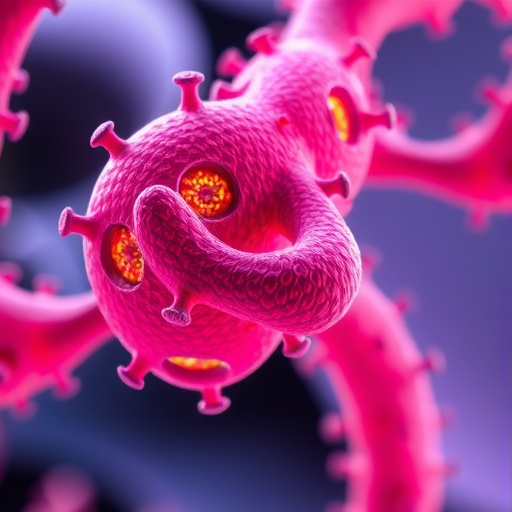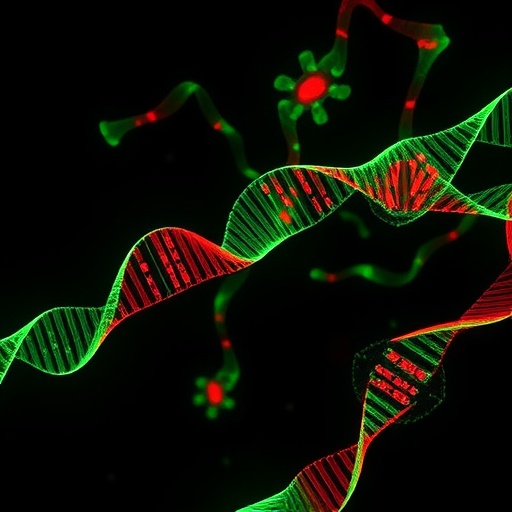In the realm of oncology, identifying reliable biomarkers for disease prognosis and treatment response is crucial for personalized medicine. The recent study by Yay and Yıldırım introduces HERC2, a gene of growing interest, as a potential biomarker in the management of ovarian cancer. Utilizing a sophisticated bioinformatics approach, the researchers analyzed data from various cancer databases, providing insights into how HERC2 might influence treatment with Bevacizumab, a widely used monoclonal antibody for the treatment of ovarian cancer. Bevacizumab works by inhibiting angiogenesis, the process through which tumors develop their blood supply, thereby starving the cancer of nutrients and oxygen.
The importance of HERC2 in the context of ovarian cancer prognosis cannot be understated. This gene has been previously associated with various cellular processes, including DNA damage response and repair, which are fundamental for maintaining genomic stability. Mutations or dysregulation in such genes can lead to tumorigenesis, making them critical targets for biomarker research. The involvement of HERC2 in DNA repair mechanisms also suggests that its expression levels may correlate with how well cancer cells can withstand chemotherapy or targeted therapies.
In their analysis, Yay and Yıldırım employed advanced bioinformatics techniques to sift through large datasets, including The Cancer Genome Atlas (TCGA) and the Gene Expression Omnibus (GEO). They focused on the expression patterns of HERC2 in ovarian cancer tissues compared to normal ovarian tissues. This comparative analysis revealed that HERC2 is often overexpressed in ovarian cancer patients, providing an intriguing avenue for its use as a prognostic tool. By digging deeper into the molecular mechanisms, the researchers found that high levels of HERC2 expression were linked to poor patient outcomes, enhancing the validity of HERC2 as a prognostic marker.
Moreover, the study meticulously explored how HERC2 expression might also predict the response to Bevacizumab therapy. The researchers found that patients with higher HERC2 levels demonstrated a reduced efficacy of Bevacizumab treatment, suggesting that HERC2 could serve as a molecular determinant in tailoring treatment strategies. The implications of these findings are profound; if validated further, HERC2 could help oncologists identify which patients are more likely to benefit from Bevacizumab therapy, avoiding unnecessary treatments for those less likely to respond.
In addition, the researchers addressed the potential molecular pathways involving HERC2 that could elucidate its role in drug resistance. The interplay between HERC2 and various signaling pathways, such as those involved in cell survival and apoptosis, was discussed. It was suggested that overexpression of HERC2 may lead to the activation of survival pathways that allow cancer cells to resist the pro-apoptotic effects of Bevacizumab. Understanding these pathways could pave the way for the development of novel therapeutic strategies aimed at downregulating HERC2 or targeting its downstream pathways.
The identification of HERC2 as a biomarker also resonates with the ongoing quest for personalized medicine in oncology. This approach emphasizes the need for tailored therapies based on individual patient characteristics, including genetic markers. As the field of precision medicine evolves, integrating biomarkers like HERC2 into clinical practice could transform how clinicians approach ovarian cancer treatment, leading to more customized and effective care protocols.
One major aspect of the study that stands out is the emphasis on a multi-faceted approach to biomarker discovery. The research team combined genomic data analysis, clinical outcome associations, and pathway exploration, showcasing a comprehensive methodology that is essential for identifying viable biomarkers. This systematic approach is necessary for driving advancements in oncology, where the complexity of tumor biology often complicates treatment decisions.
As ovarian cancer remains one of the deadliest gynecological malignancies, the findings from Yay and Yıldırım take on an added urgency. The study not only opens avenues for future research but also highlights existing gaps in our understanding of ovarian cancer biology. Continued research is essential to validate these findings in larger, multi-institutional cohorts, ultimately leading to integration into clinical practice.
Beyond the academic implications, the potential clinical application of HERC2 as a biomarker could significantly impact patient care and outcomes. It could lead to more informed treatment choices, better patient selection for Bevacizumab, and possibly the development of adjunct therapies that specifically target HERC2 or its related pathways. In a field where treatment decisions can be the difference between life and death, the pursuit of such biomarkers cannot be overstated.
Despite the compelling nature of the study, several questions remain. Future investigations should seek to clarify the mechanistic role of HERC2 in ovarian cancer biology. Additionally, understanding the interplay between HERC2 and other molecular markers in the context of Bevacizumab therapy could yield deeper insights into how best to manage treatment resistance. The journey from biomarker discovery to clinical implementation is complex, but studies like this pave the way for the promising future of bespoke cancer treatments.
Moreover, this research could lead to increased awareness and funding for similar investigations that target relatively understudied genes. By bringing HERC2 into the spotlight, Yay and Yıldırım’s work serves as a catalyst for further research across various cancer types where similar types of gene dysregulation may be found. The interconnectedness of biomarkers across different cancers suggests that findings from one area can have far-reaching implications for others.
In conclusion, the study by Yay and Yıldırım marks a significant step forward in our understanding of ovarian cancer and the intricate web of genetic factors involved. By proposing HERC2 as a potential biomarker for prognosis and treatment response, they have opened doors to both enhanced patient stratification and a better grasp of the biological systems underpinning drug resistance. As the scientific community eagerly anticipates further confirmation of these findings, the hope is that this research will contribute to the ultimate goal of improving outcomes for patients battling ovarian cancer worldwide.
Subject of Research: HERC2 as a potential biomarker in ovarian cancer prognosis and response to Bevacizumab
Article Title: HERC2 as a Potential Biomarker for Prognosis and Response to Bevacizumab in Ovarian Cancer: A Bioinformatics Approach
Article References: Yay, F., Yıldırım, H.Ç. HERC2 as a Potential Biomarker for Prognosis and Response to Bevacizumab in Ovarian Cancer: A Bioinformatics Approach. Reprod. Sci. (2025). https://doi.org/10.1007/s43032-025-01977-6
Image Credits: AI Generated
DOI:
Keywords: HERC2, ovarian cancer, biomarker, Bevacizumab, prognosis, bioinformatics.
Tags: angiogenesis inhibition in tumorsBevacizumab treatment responsebioinformatics in cancer researchbiomarkers for personalized medicinecancer databases analysischemotherapy resistance in ovarian cancerDNA damage response in cancergenomic stability and tumorigenesisHERC2 gene in ovarian cancermutations in cancer biomarkersovarian cancer prognosis markerstargeted therapies in ovarian cancer





